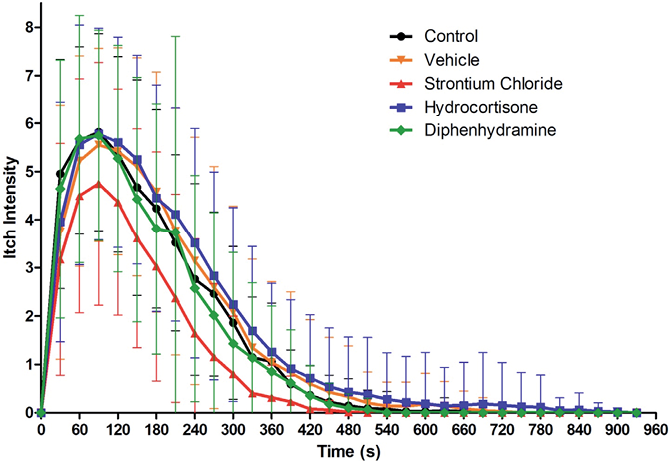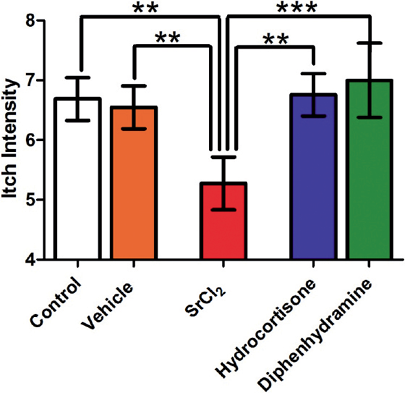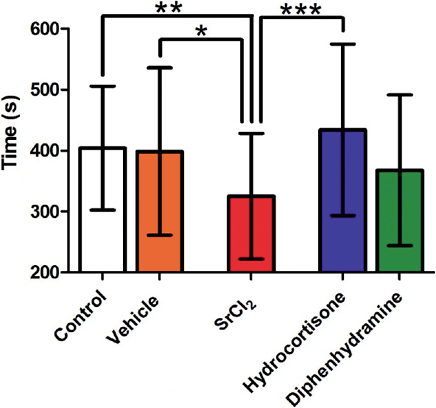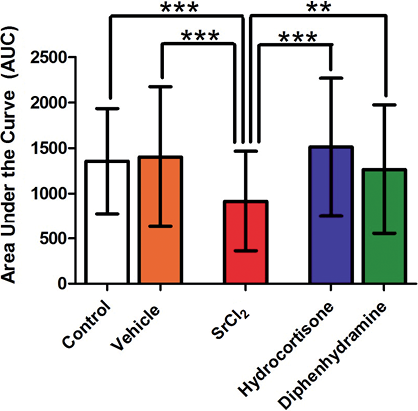Alexandru D. P. Papoiu1#, Rodrigo Valdes-Rodriguez1#, Leigh A. Nattkemper1,2, Yiong-Huak Chan4, Gary S. Hahn5 and Gil Yosipovitch1–3
Departments of 1Dermatology, 2Neurobiology & Anatomy, and 3Regenerative Medicine, Wake Forest School of Medicine, Winston-Salem, NC, USA and 4Biostatistics Unit, Yong Loo Lin School of Medicine, National University of Singapore, Clinical Research Centre, Singapore, Singapore and 5Cosmederm Biosciences, San Diego, CA, USA
#These authors contributed equally to this report and should be considered as first authors.
The aim of this double-blinded, vehicle-controlled study was to test the antipruritic efficacy of topical strontium to relieve a nonhistaminergic form of itch that would be clinically relevant for chronic pruritic diseases. Itch induced with cowhage is mediated by PAR2 receptors which are considered to play a major role in itch of atopic dermatitis and possibly other acute and chronic pruritic conditions. The topical strontium hydrogel formulation (TriCalm®) was tested in a head-to-head comparison with 2 common topical formulations marketed as antipruritics: hydrocortisone and diphenhydramine, for their ability to relieve cowhage-induced itch. Topically-applied strontium salts were previously found to be effective for reducing histamine-induced and IgE-mediated itch in humans. However, histamine is not considered the critical mediator in the majority of skin diseases presenting with chronic pruritus. The current study enrolled 32 healthy subjects in which itch was induced with cowhage before and after skin treatment with a gel containing 4% SrCl2, control vehicle, topical 1% hydrocortisone and topical 2% diphenhydramine. Strontium significantly reduced the peak intensity and duration of cowhage-induced itch when compared to the control itch curve, and was significantly superior to the other two over-the-counter antipruritic agents and its own vehicle in antipruritic effect. We hereby show that a 4% topical strontium formulation has a robust antipruritic effect, not only against histamine-mediated itch, but also for non-histaminergic pruritus induced via the PAR2 pathway, using cowhage. Key words: strontium hydrogel; topical antipruritic; cowhage itch.
Accepted Dec 4, 2012; Epub ahead of print Mar 8, 2013
Acta Derm Venereol 2013; 93: XX–XX.
Gil Yosipovitch, MD, Department of Dermatology, Wake Forest School of Medicine, Medical Center Boulevard, Winston-Salem, NC 27157, USA. E-mail: gyosipov@wakehealth.edu.
Recently, we have reported a new experimental model for itch induction in humans using cowhage spicules (Mucuna pruriens) (1, 2). Cowhage is known to induce itch by releasing mucunain, a cysteine protease that activates proteinase activated receptors 2 (PAR2) on nerve fiber endings present in the skin (3). This model is suitable for the study of itch because it closely resembles the characteristics of pruritus in chronic conditions such as atopic eczema (4, 5).
Despite the fact that neurobiology of itch has grown considerably in the last decade (6, 7), very few novel topical antipruritic medications have emerged (8). Topical strontium, formulated in water-soluble salts such as chloride or nitrate, has been shown to be able to inhibit sensory irritation (9, 10) and to reduce histamine-induced itch (11). However, neither strontium nor other topical antipruritic medications, such as hydrocortisone and diphenhydramine, have been tested in a non-histaminergic model of itch, such as cowhage-induced pruritus. The scope of this study was to test the antipruritic effect of a topical hydrogel formulation containing 4% SrCl2 hexahydrate (TriCalm®) in reducing cowhage itch intensity and duration, when the skin was pretreated with the topical agent 15 min prior to itch induction. The antipruritic efficacy of TriCalm® was tested head-to-head with two other over-the-counter topical agents marketed as antipruritics, and its own vehicle.
MATERIALS AND METHODS
Subjects
Thirty-two healthy subjects (18 women and 14 men) between 21 and 58 years of age (mean ± SD age 27.8 ± 8 years) participated in this study. Subjects were not taking any oral or topical medications and were free of any skin disease. All procedures were approved by the Wake Forest University Health Sciences Institutional Review Board. All volunteers provided written informed consent.
Design overview
Cowhage spicules and the topical antipruritic agents were applied in the following sequence. First, itch was induced with cowhage as a control in the absence of any treatment, on the upper side of the volar aspect of the right forearm, on a 16 cm2 (4 × 4 cm) square area. Then, in a double-blinded fashion, randomized applications (vide infra) of topical diphenhydramine, hydrocortisone, strontium hydrogel and vehicle hydrogel were performed, on 4 other rectangular areas of the same size, two each on the right and left forearms. After 15 min of pre-treatment, the excess (unadsorbed) topical agents were removed. Cowhage spicules were applied in the same fashion as the control, in 4 distinct experiments. Each experiment using a different topical agent was separated from the subsequent one by a break of 20 min, counted from the moment when itch subsided in the previous step. Itch intensity was assessed every 30 s until itch sensation had completely subsided for all conditions. The overall itch duration (in seconds) was also recorded.
Antipruritic medication tested
A volume of 0.8 ml (a layer 0.5 mm thick evenly spread over a 40 × 40 mm area) of diphenhydramine 2% (LaVita Compounding Pharmacy, San Diego, CA, USA), hydrocortisone 1% (RiteAid, Camp Hill, PA, USA), a 4% strontium chloride hexahydrate in a hydrogel formulation (TriCalm®, Cosmederm Bioscience, San Diego, CA, USA) and control vehicle were applied evenly on the 4 test areas of the skin (2 on each forearm).
The randomization design for the application of topical agents on the forearms was performed as follows: one fixed area was designated as the control site for all participants, on the upper site of the right forearm. Two different sites were designated on the right forearm as sites 1, 2 and other two on the left forearm as sites 3, 4 for the application of the 4 topical agents [A, B, C, D]. A permutation scheme was developed following a Williams design (12–14), with 4 sequences of applications repeated at every 4 subjects, in such a way that every test site [1, 2, 3, 4] received a topical agent just once, and the order of application was changed for the next participant, with a repetition period of 4. This scheme conferred uniformization upon the completion of 4 sequences, in which no sequence had the same two agents applied consecutively in the same order. In this way, the design changed two factors in the same time: the pairing of each site with a different agent, and the order in which the creams were applied. This design was selected to avoid order effects and a potential pairing selection bias of the same test area with the same agent. The following scheme of permutations, called a Williams single, was repeated at every 4 subjects.
|
Subject # |
Area 1 |
Area 2 |
Area 3 |
Area 4 |
|
001 |
A |
D |
B |
C |
|
002 |
B |
A |
C |
D |
|
003 |
C |
B |
D |
A |
|
004 |
D |
C |
A |
B |
Cowhage itch induction
Itch was evoked by the application of 40–45 cowhage spicules, which were counted under a magnifying lens and then were rubbed into the subject’s skin by a study investigator. The spicules were rubbed gently in a circular motion within a 16 cm2 square area of skin, for 45 s. At the conclusion of each experiment, when itch has subsided, the spicules were removed using adhesive tape (Scotch; 3M, St. Paul, MN, USA).
Psychophysical quantification of itch intensity
Cowhage itch was recorded for its full duration until it completely subsided. The starting point (t0) for collection of ratings coincided with the moment when cowhage application was stopped. Spicules were left in place until experiments were concluded and itch ratings completely and stably returned to zero (until 3 consecutive zero-s were recorded). Subjects rated their itch intensity every 30 s using a numerical 10 cm VAS scale, from 0 (no itch) to 10 (maximum unbearable itch).
Statistical analysis
All statistical analyses were performed using PASW 18.0 software (SAS, Chicago, IL, USA) with statistical significance set at p < 0.05. Repeated measures ANOVA followed by post-hoc tests and Bonferroni corrected for multiple comparisons was performed to compare the mean VAS ratings at each 30 s time-point between the strontium active hydrogel, vehicle hydrogel, topical hydrocortisone, diphenhydramine and control. The peak VAS ratings, area under the curve (AUC) and the overall duration for each treatment were compared using a mixed model and post-hoc analyzed by Least Square Difference method (Fisher’s test). Furthermore, all analyses were performed between genders (and no significant difference was found between male and female subjects).
RESULTS
Itch intensity
The mean VAS scores of itch intensity peaked around the 90 s time-point for each treatment and also for the control itch curve (cowhage alone), as shown in Fig. 1, which depicts the entire time course of itch for all 5 conditions. The strontium chloride hydrogel decreased the maximum itch intensity of cowhage itch - analyzed as the MAX value reported at any point during recording – by 1.42 VAS units compared to control curve, which corresponds to a 21.2% reduction (5.27 ± 2.51 for SrCl2 vs. 6.69 ± 1.91 control; p < 0.003), and was superior to its own vehicle (6.55 ± 2.03; p < 0.007), hydrocortisone (6.76 ± 2.01; p < 0.002), and diphenhydramine (7.00 ± 3.52; p < 0.001) as shown in Fig. 2.

Fig. 1. Time-course of itch. Strontium chloride hydrogel reduced itch intensity as revealed by instantaneous VAS ratings taken every 30 s. Itch reduction reached statistical significance compared to control itch curve at time points: 30, 270, 300, 330s; vs. vehicle at 150, 240, 270, 300, 330, 360 s; vs. 1% hydrocortisone at 150, 240, 270, 300, 330, 360 s points and vs. 2% diphenhydramine at 30 s and 330 s time-points. The VAS scale was anchored between 0 (no itch) and 10 (maximum unbearable itch).
Fig. 2. Peak itch intensity was analyzed as the absolute maximum value recorded for itch intensity at any given time point. The strontium chloride hydrogel significantly reduced peak itch intensity compared to the control itch (**p = 0.004) and its vehicle (**p = 0.008), and exerted a superior antipruritic effect compared to 1% hydrocortisone (**p = 0.002) and 2% diphenhydramine (***p < 0.001).

Itch duration
The strontium hydrogel significantly decreased itch duration (325 ± 103 s) by 79 ± 30 s in comparison to the control itch (404 ± 102; p < 0.009), which represents a 20% reduction (Fig. 3). It was followed by diphenhydramine with a reduction of 36 s (368 ± 108, n.s.), the hydrogel vehicle with 6 s (398 ± 137), while the hydrocortisone cream increased itch duration with 30 s (434 ± 141, n.s.), in comparison to the control itch curve. Compared to the other agents, the strontium chloride formulation was superior to hydrocortisone (itch was reduced 109 ± 30 s faster by strontium, p < 0.001), and to its own vehicle (faster by 74 ± 30 s, p < 0.015).
Fig. 3. Duration of itch. The SrCl2 hydrogel significantly reduced the duration of itch compared to control itch curve by 79 ± 30 s (**p < 0.007), its own vehicle control by 74 s (*p < 0.05), and was superior to hydrocortisone by 109 s (***p < 0.001) and diphenhydramine by 43 s.

We also quantified the time-course of itch intensity over time in the integral measure of AUC, representing the total itch perceived for the full duration, for all 5 conditions studied (Fig. 4). Pretreatment with the strontium hydrogel significantly decreased total perceived itch (median AUC; p < 0.001), when compared to itch control, hydrocortisone, diphenhydramine (p < 0.01) and vehicle, in all head-to-head comparisons.
Fig. 4. Area under the curve (AUC) of itch intensity time course measured the total itch perceived over the entire duration of the experiment for each condition. The strontium chloride formulation significantly reduced total itch perceived compared to control itch (***p = 0.001), vehicle (***< 0.001), hydrocortisone (***< 0.001) and diphenhydramine (**p < 0.01).

DISCUSSION
Topical management of chronic itch is still challenging (15, 16). Very few topical drugs have shown efficacy for chronic itch (8). We hereby report the first double blind, vehicle-controlled cross-over study using the cowhage itch model for testing antipruritic medications. We found that the strontium chloride hydrogel has a more effective antipruritic effect than the most commonly used over-the-counter (non-prescription) topicals currently marketed as antipruritics in the US. In a previous report, it was also shown that a strontium-containing formulation decreased the intensity and duration of itch induced with histamine (11) and IgE-dependent itching in antigen-induced skin challenge studies.
The exact mechanism underlying the antipruritic effect of strontium salts is not well understood. Due to the similarities in size, charge and chemical characteristics between Sr2+ and Ca2+ ions, strontium ions could present the ability to compete with calcium for receptor binding and transport via calcium channels, which can ultimately lead to inhibition of calcium-dependent depolarization of C-type nerve fibers. Indeed, strontium ions can interact with calcium sensing receptors (CaSR), a G-protein coupled receptor present on type C nerve fibers (17). In vitro studies using strontium compounds demonstrate that it binds and activates the calcium sensing receptor (CaSR) as an ‘orthosteric regulator’ (type I agonist) (18), which can ultimately lead to a depressed nociceptor/pruritoceptor activation and synaptic transmission (19). A permeability study of strontium flux thorough voltage-dependent ion channels showed that strontium traverses calcium ion channels at a greater rate than calcium itself (20). In addition, strontium can modulate the permeability of other ion channels (K+ channels) which are voltage-gated by L-type calcium channels (21). It has been found that the presence of strontium ions can alter the local availability of calcium, by competitively binding to endogenous divalent ion buffers, albeit weakly (22).
Actions of strontium in the nervous system, especially at the level of synapse have been reported. Strontium can substitute calcium to trigger neurotransmitter release and it was employed as an experimental tool to study this process (23). Studies at the squid giant synapse (24), the neuromuscular junction (25–29) and at central synapses (30, 31) have shown that strontium triggers a ‘desynchronized’ neurotransmitter release with a reduced peak and prolonged duration. Therefore, it was suggested that Sr2+ is less effective than Ca2+ in triggering exocytotic transmitter release (32, 33). Strontium was also used to identify high-affinity calcium sensors, such as synaptotagmin III, based on their high strontium binding affinity (34). However, it is presently unclear whether the antipruritic action of strontium is mediated by effects disrupting synaptic transmission, neurotransmitter release or depolarization.
In light of the demonstrated antipruritic efficacy of this preparation (TriCalm®), further studies investigating the antipruritic effect of strontium-based formulations in chronic itch conditions would be timely. This study confirms the usefulness of the cowhage model for itch and implicitly of the PAR2 pathway for testing topical antipruritic preparations.
ACKNOWLEDGEMENT
Conflict of interest: GY is a consultant for Cosmederm.
Funding source: Cosmederm Inc.
REFERENCES
